Pyroptosis impacts the prognosis and treatment response in gastric cancer via immune system modulation
- PMID: 35530274
- PMCID: PMC9077078
Pyroptosis impacts the prognosis and treatment response in gastric cancer via immune system modulation
Abstract
Pyroptosis plays a vital role in the development of cancers; however, its role in regulating immune cell infiltration in tumor microenvironment (TME) and pyroptosis-related molecular subtypes remain unclear. Herein, we comprehensively analyzed the molecular subtypes mediated by the pyroptosis-related genes (PRGs) in gastric cancer (GC). Three pyroptosis patterns were determined with distinct TME cell-infiltrating characteristics and prognosis. Principal component analysis was performed to establish the pyroptosis score. The high pyroptosis score group was featured by increased activated CD4+ T cell infiltration, better prognosis, elevated tumor mutation burden, higher immune and stromal scores, and enhanced response to immunotherapy. However, the low pyroptosis score group was characterized by poorer survival, decreased immune infiltration, and glycerolipid and histidine metabolism pathways. Additionally, high pyroptosis score was confirmed as an independent favorable prognostic factor for overall survival. Three cohorts designed to analyze the response to immunotherapy verified that patients with higher pyroptosis score showed treatment benefit. In summary, our study demonstrated that pyroptosis regulates the complex TME. Assessing the pyroptosis patterns will advance our understanding on TME features and tumor immunology and provide the rationale for designing personalized immunotherapy strategies.
Keywords: Pyroptosis; gastric cancer; immunotherapy; prognosis; tumor microenvironment.
AJCR Copyright © 2022.
Conflict of interest statement
None.
Figures
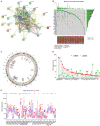


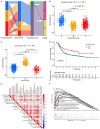
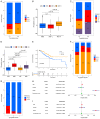
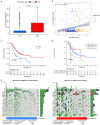
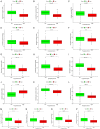
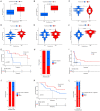
Similar articles
-
Pyroptosis Patterns Characterized by Distinct Tumor Microenvironment Infiltration Landscapes in Gastric Cancer.Genes (Basel). 2021 Sep 28;12(10):1535. doi: 10.3390/genes12101535. Genes (Basel). 2021. PMID: 34680930 Free PMC article.
-
Pyroptosis-related gene mediated modification patterns and immune cell infiltration landscapes in cutaneous melanoma to aid immunotherapy.Aging (Albany NY). 2021 Nov 9;13(21):24379-24401. doi: 10.18632/aging.203687. Epub 2021 Nov 9. Aging (Albany NY). 2021. PMID: 34753832 Free PMC article.
-
Pyroptosis patterns of colon cancer could aid to estimate prognosis, microenvironment and immunotherapy: evidence from multi-omics analysis.Aging (Albany NY). 2022 Sep 23;14(18):7547-7567. doi: 10.18632/aging.204302. Epub 2022 Sep 23. Aging (Albany NY). 2022. PMID: 36152052 Free PMC article.
-
The implication of pyroptosis in cancer immunology: Current advances and prospects.Genes Dis. 2022 May 12;10(6):2339-2350. doi: 10.1016/j.gendis.2022.04.019. eCollection 2023 Nov. Genes Dis. 2022. PMID: 37554215 Free PMC article. Review.
-
Clinical significance of tumor-infiltrating lymphocytes for gastric cancer in the era of immunology.World J Gastrointest Oncol. 2017 Jul 15;9(7):293-299. doi: 10.4251/wjgo.v9.i7.293. World J Gastrointest Oncol. 2017. PMID: 28808502 Free PMC article. Review.
Cited by
-
Sparse spectral graph analysis and its application to gastric cancer drug resistance-specific molecular interplays identification.PLoS One. 2024 Jul 5;19(7):e0305386. doi: 10.1371/journal.pone.0305386. eCollection 2024. PLoS One. 2024. PMID: 38968283 Free PMC article.
-
Pyroptosis in gastric mucosal injury‑related diseases (Review).Int J Mol Med. 2025 Oct;56(4):165. doi: 10.3892/ijmm.2025.5606. Epub 2025 Aug 8. Int J Mol Med. 2025. PMID: 40776743 Free PMC article. Review.
-
The role of inflammasomes in human diseases and their potential as therapeutic targets.Signal Transduct Target Ther. 2024 Jan 5;9(1):10. doi: 10.1038/s41392-023-01687-y. Signal Transduct Target Ther. 2024. PMID: 38177104 Free PMC article. Review.
-
Application of pyroptosis score in the treatment and prognosis evaluation of gastric cancer.Zhong Nan Da Xue Xue Bao Yi Xue Ban. 2023 Dec 28;48(12):1882-1889. doi: 10.11817/j.issn.1672-7347.2023.230258. Zhong Nan Da Xue Xue Bao Yi Xue Ban. 2023. PMID: 38448382 Free PMC article. Chinese, English.
-
C6 and KLRG2 are pyroptosis subtype-related prognostic biomarkers and correlated with tumor-infiltrating lymphocytes in lung adenocarcinoma.Sci Rep. 2024 Oct 22;14(1):24861. doi: 10.1038/s41598-024-75650-4. Sci Rep. 2024. PMID: 39438534 Free PMC article.
References
-
- Siegel RL, Miller KD, Jemal A. Cancer statistics, 2020. CA Cancer J Clin. 2020;70:7–30. - PubMed
-
- Yang W, Ma J, Zhou W, Cao B, Zhou X, Yang Z, Zhang H, Zhao Q, Fan D, Hong L. Molecular mechanisms and theranostic potential of miRNAs in drug resistance of gastric cancer. Expert Opin Ther Targets. 2017;21:1063–1075. - PubMed
-
- Johnston FM, Beckman M. Updates on management of gastric cancer. Curr Oncol Rep. 2019;21:67. - PubMed
-
- Helmy KY, Patel SA, Nahas GR, Rameshwar P. Cancer immunotherapy: accomplishments to date and future promise. Ther Deliv. 2013;4:1307–1320. - PubMed
-
- Zhuo M, Chi Y, Wang Z. The adverse events associated with combination immunotherapy in cancers: challenges and chances. Asia Pac J Clin Oncol. 2020;16:e154–e159. - PubMed
LinkOut - more resources
Full Text Sources
Research Materials
Miscellaneous
